
the Game Improvement Helper_ (7) |
Palmer Methods |
|
Vintage 1963, still applies today, and will tomorrow.
Arnie had it right.
|

|
FEEL 'INWARD' WHEN PUTTING
The most important thing about putting is to remain absolutely motionless. Only your hands and arms should move during the stroke. To eliminate body movement, I try to feel "inward" when I set up. I like to feel that my elbows and my knees are pinched in toward an imaginary axis that runs through the middle of my body. This feeling keeps my weight centered and my body quiet throughout the stroke.
Keeping your body quiet during the stroke is still my No. 1 putting key--and nobody does that better than Tiger.
|
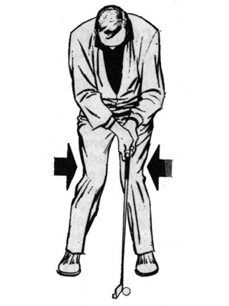
|
KEEP IT COMPACT FOR CONTROL
Try to keep the club under control at all times, especially at the top of the backswing. Each of us has physical limits. We can take the club back just so far. You've got to keep the backswing compact and well within your natural capabilities. Because the minute you're stretching yourself as you swing back, the minute you're fighting the weight of the club instead of remaining easily in control of it, you've swung too far.
When you go too far, one of two things happens: You bend your left elbow, or the grip gets loose in your hands. Either way, you're lost.
Long and loose is still a bad idea. There aren't very many good players like John Daly.
|
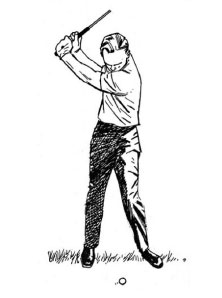
|
HITTING BEHIND BALL? ACCENTUATE LEG ACTION
Golfers of every ability level occasionally hit behind the ball on key shots. If this problem persists in your game, I suggest you stress foot and leg action in your downswing. Striking the turf behind the ball -- hitting "fat" as they say -- usually is caused by failure to shift enough weight onto the left foot on the downswing.Good legwork is the answer in making this weight shift properly. As you begin to move into your downswing, drive your legs to the left (see illustration) while keeping your upper body in position. This leg action will tend to "level out" the path of your clubhead in the hitting area, and the clubface will move squarely into the back of the ball.
|
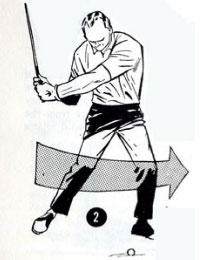
|
SHORT BACKSWING FOR SHORT SHOTS
A common fault among novice golfers is taking too long a backswing on the shots from within, say 40 yards of the green. After taking a long backswing, they let the clubhead "coast" into the ball. In short, such golfers are regulating the length of the shot by the force of the swing, rather than its length. Failure to accelerate the clubhead into the ball produces a sloppiness and loss of club control. Scuffed or topped shots result.In the illustration I am hitting a wedge shot of about 30 yards. Note that my backswing is short -- the hands barely reach hip height -- and then I gradually accelerate the speed of the clubhead as it moves into and through the ball.
Learn to regulate the distance you hit these shots by the length of your backswing. Thus, you will be able to strike at the ball with about the same force on all shots, regardless of their length. You will not only hit these shots more squarely, but you will also develop a more sensitive touch.
|
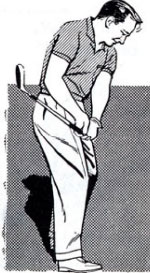
|
IMAGINE WHISK ON CHIP SHOTS
Sometimes words sound like what they describe. A good example is the broom. Anyone who has used one knows it goes whisk when you sweep.I think whisk is a good sound to think about when you hit a chip shot. The clubhead should brush the grass and whisk the shot on its way.
There is nothing lazy or sloppy about a chip. It's quick and firm. It whisks.So make your chips whisk. You might even imagine that you're swinging a broom. Very good image. Not only for the sound, the swing shape should be a sweep, too.
|
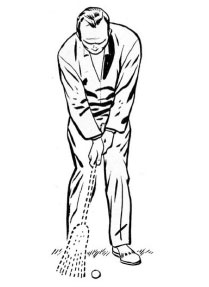
|
RETURN YOUR RIGHT ELBOW TO YOUR SIDE
Starting down, I'm conscious of unwinding the muscles of my left side, which were coiled on the backswing. My left arm is straight, and my right elbow moves back to my right side as quickly as possible. The move to be avoided at all cost is letting the right hand take over at this point in the swing.The feeling that I get near and at impact is that my hands are ahead of the ball.
My left hand guides the club, and my right hand supplies the hitting power at impact. I'd add this: Push off your right foot through the shot, and keep a steady head.
|
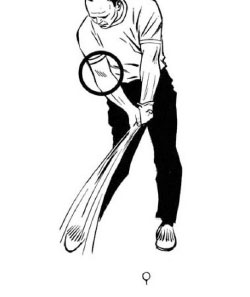
|
THINK OF THE TURN AS A BARBER POLE
The turn starts with the movement of the club back and can be likened to one of those old-fashioned barber poles. The red, white and blue lines that go around the pole represent the body, and the pole is the stance, with the feet and head held firmly to make sure that the club gets back to where it started.
It's essential that everything starts at once.
|
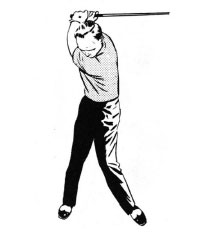
|
STAY OVER THE BALL ON THE BACKSWING
The turn starts with the movement of the club back and can be likened to one of those old-fashioned barber poles. The red, white and blue lines that go around the pole represent the body, and the pole is the stance, with the feet and head held firmly to make sure that the club gets back to where it started.
It's essential that everything starts at once.
|
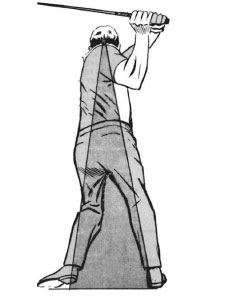
|
START OUT WITH A STRONG LEFT HAND
Once the left-hand grip is taken properly, it's simple to add the right hand.
So be sure to take more time with the left. The shaft should cross the left palm diagonally from the bottom (or outer) joint of the forefinger to just below the little finger. This position produces a "strong" left hand, in which the "V" formed by the forefinger and thumb points to the right shoulder. Fold your left hand over the club, and make sure the thumb rests on the right-top part of the shaft.
For the beginner, a strong left-hand grip works best. You can always weaken it later to lessen a hook; that's what I did.
|
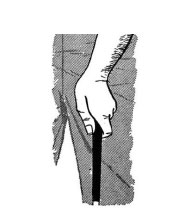
|
THREE FINGERS THAT MAKE YOUR GRIP
An effective grip requires strong hands, especially the last three fingers of the left hand, which will be the first to let go of the club at the top of the swing. To strengthen these fingers, squeeze the steering wheel of your car with them, as tightly as you can, for 10 seconds every time you drive. This exercise will do more for your game than any drill I can imagine.
|
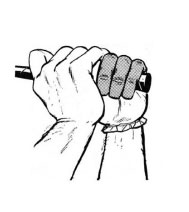
|
ALWAYS KEEP YOUR HEAD IN PLACE
Getting comfortable over the ball is a big part of keeping your head still: If you've got nice balance and your feet are good and firm, you have a far better chance to do it. Relaxation is part of it: If your body movements flow free and easy, there's no physical force to pull you off your axis. But it's mostly a matter of concentration.
You've just got to be determined to hold steady. If a proper grip is the first fundamental in golf, then keeping your head steady is the next.
|
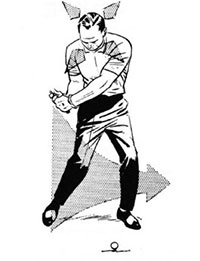
|
PICK PUTTING OVER CHIPPING
Never feel guilty about putting from off the green, as long as you think that the putter will give you the best chance for a successful result. Keep in mind that putting from the fringe makes the most sense when the ball is sitting cleanly or the grass is lying toward the hole. When the grass is lying away from the green or the ball is sitting down even a little, you might be better off chipping with a 5- or 6-iron.That said, amateurs will almost always be more effective putting the ball.
Your worst putt is usually better than your best chip.
If you don't believe me that putting is better, take 10 balls and hit five with a wedge and five with your putter from just off the green. Take the average distance you leave yourself, and you'll see what I mean.
|
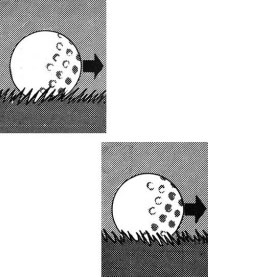
|
ON SHORT SHOTS, WEIGHT STAYS TO LEFT
On chip shots from around the edge of a green, we must make certain that the club does not strike the ground before it meets the ball (No. 1). The best way to avoid such scruffed shots is to address the ball with your hands slightly ahead of the ball and with most of your weight on your left foot (No.2 and No. 3). Then keep your weight on your left foot throughout your chipping stroke. Keeping your weight to the left will cause your club to brush the grass and sweep the ball into the air.
Only when your hands move behind the ball or your weight shifts to the right will you be in danger of scruffing the shot.
|
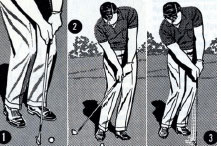
|
POINT THE SHOULDER TOWARD THE BALL
The shoulder turn occurs on a tilted plane, so the left shoulder should move down as well as around on the backswing.If you've properly tilted and turned your shoulders going back, your left shoulder should point toward the ball at the top of the swing. This backswing turn will put you in the right position to strike the ball squarely and forcefully. Many average golfers, especially those who have played baseball, turn their shoulders on too much of a level plane. Rotation like this makes the swing too flat and limits your chances of hitting the ball with a square clubface.
I love this illustration--take another look. Turning level is a big problem, just like it was in the '60s when I wrote this tip.
|
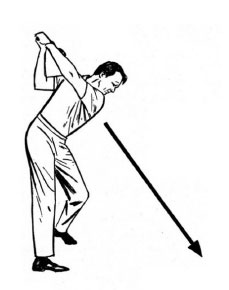
|
Return to Helpers lists |
Tempo and Rhythm Drill |
Rhythm is swinging at a steady, even rate.
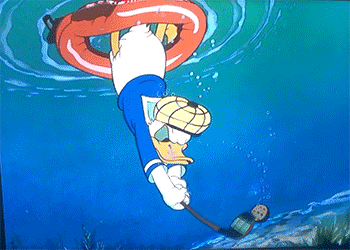
Tempo is the speed(s) at which one can swing a golf club while in Rhythm.
Here's a good drill to acquire a skill/habit with Rhythm and Tempo.
-
DRILL: GET UINDER WATER
- REQUIREMENT: some imagination !
- SHOT TO PRACTICE: short pitching
Use "whatever" technique you would use to hit a 10 to 30 yard pitch shot, using a wedge (51 to 60 degrees).
(1)_ PRETEND/VISUALIZE YOU ARE swinging UNDER WATER
(imagination is required)
(2)_Hit first a 7 to 10 yard shot and note where the ball strikes the ground..
(3)_Next, hit the second one a little further than the first, hitting the ground just past first ball's ground strike.
(4)_Next, hit the third one a little further than the second, hitting ground just past last strike, not too far past 30 yards...
With this "Hopscotch" drill , doesn't matter so much where the ball comes to rest as much as where did the ball strike the ground.
Got to start drill over if you can't control the ball's ground strike area in the proper sequences. Good way to determine if a swing technique upgrade might be in order?
Do within a maximum distance of 30 yards, minimum ground strike area of 7 to 10 yards.
If you can do 3 times in row, then reverse the sequences. If you can do, you're getting good....
.... Congratulations
You should start to notice how the size of back swing will dictate how much energy is put on the ball, NOT by flipping, scooping or pounding down at ball.
More of letting ball get in way of swing, with an equal size back swing and finish every time.
Swinging while feeling under water, sticking the swing's FINISH (pose) with each successful swing. Do enough times should create a good habit . Got to be under water remember.
Lastly, now try with different wedges / lofts. (like 48 to 60+ degrees). More the loft, higher the ball flight, bigger swing required. Less loft a club has, smaller swing, lower ball flight. Right ??
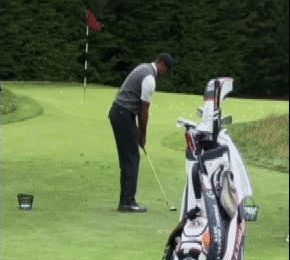
- Start with ball position at address towards back foot for this drill.
- Different ball positions can control trajectory, this drill is more for distance- balance- rhythm control than how high or low you may be trying to hit a shot.
- Weight should favor front leg (closest to target) throughout stroke. A standard principle for pitch shots.
Be sure to finish all swings to a holding-resting-position, "Pose".
Don't come out of that finish position until the ball strikes the ground.

Yes, this drill could work with any swings in principle.
Works more for short game swings (putt-chip-pitch) than full swings that require more speed in your tempo..
After somewhat developing the skill/habits of this drill, one can surely speed things up when needed.
Be careful, "feel" like you are somewhat still "under water" to finish.
You know, like Donald do.

note: definition of Pitch Shot is when ball is in air longer than on the ground as opposed to chip or putt when ball in on ground longer than in the air.
(practice before trying on golf course, which should always be the case.)
|
Return to Helpers lists |
|
|


